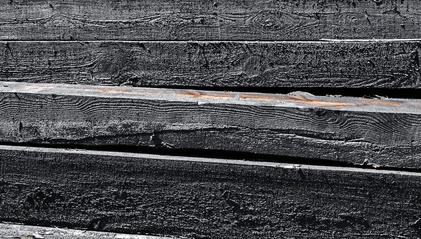A Short Guide to Railway Sleepers
Despite their name, railway sleepers are used for more than just railways. In fact, they have become an essential component for various construction and gardening projects. If you’re thinking of building a raised bed, pathway or retaining wall, railway sleepers may be the way to go.
In this guide, we take a look at railway sleepers, including their many uses, the difference between hardwood and softwood varieties, their longevity, cutting techniques, installation methods and more.
What Are Railway Sleepers and What Are They Made Of?
Railway sleepers, traditionally used to support train tracks, have evolved into a popular material for landscaping and construction. These robust, rectangular blocks, known as wooden railway sleepers, are typically crafted from various types of timber.
What makes timber so great is its exceptional durability and versatility. You can find railway sleepers in oak, pine, and other hardwoods or softwoods, each offering unique characteristics in terms of strength, texture, and longevity. But whichever you choose, you’ll always get high-quality, long-lasting wood to use in your projects.
What Can You Use Railway Sleepers For?
Garden sleepers, as they’re often called when used in landscaping, serve multiple purposes. They are ideal for creating raised beds, garden borders, steps, retaining walls and rustic outdoor furniture. Their robustness and aesthetic appeal make them a favoured choice, whether you’re a garden enthusiast, landscape architect or just a passionate DIYer.
They can even be used in larger construction projects to provide a material that is both sturdy and visually appealing.

What’s the Difference Between Softwood and Hardwood Sleepers?
The choice between softwood railway sleepers and hardwood ones is crucial. Hardwood sleepers, like oak, are:
– Denser
– More durable
– Naturally resistant to decay and pests
On the other hand, softwood sleepers, typically pine, are:
– Lighter
– More affordable
– Easier to work with
Both have their advantages, although softwood they may not last as long as their hardwood counterparts unless treated.
How Long Will Sleepers Last?
The lifespan of railway sleepers largely depends on the material and whether they are treated. Hardwood sleepers can last up to 25 years or more, while softwood sleepers, especially if untreated, may have a shorter lifespan.
How To Cut Railway Sleepers
Cutting railway sleepers requires some preparation and the right tools. You’ll likely need a powerful saw, such as a circular saw or a chainsaw, to power through the wood. It’s crucial to measure and mark your cutting line before you start so that you always cut the wood accurately. Oh, and always wear protective gear to stay safe (think goggles, gloves etc).
How To Lay Railway Sleepers
Laying railway sleepers for garden projects involves a few key steps.
1. Prepare a level base — soil, gravel or concrete — depending on the project.
2. Position the sleepers and secure them in place, either by stacking them for raised beds or embedding them into the ground for borders.
3. Make sure they are aligned and level, using screws or brackets for added stability.
Do I Need to Apply Treatments to Sleepers?
Untreated hardwood sleepers are naturally durable but applying a preservative can extend their lifespan. For softwood sleepers, treatment is highly recommended to protect against rot and pests. There are various eco-friendly and safe preservative options available that can prolong the life of your sleepers without harming the environment.
For more information or to purchase quality railway sleepers for yourself, contact the Hitchcock & King team. We offer a wide range of options, including softwood and hardwood sleepers, for all your construction and landscaping needs.
Need product advice or to place an order? Let us call you.
